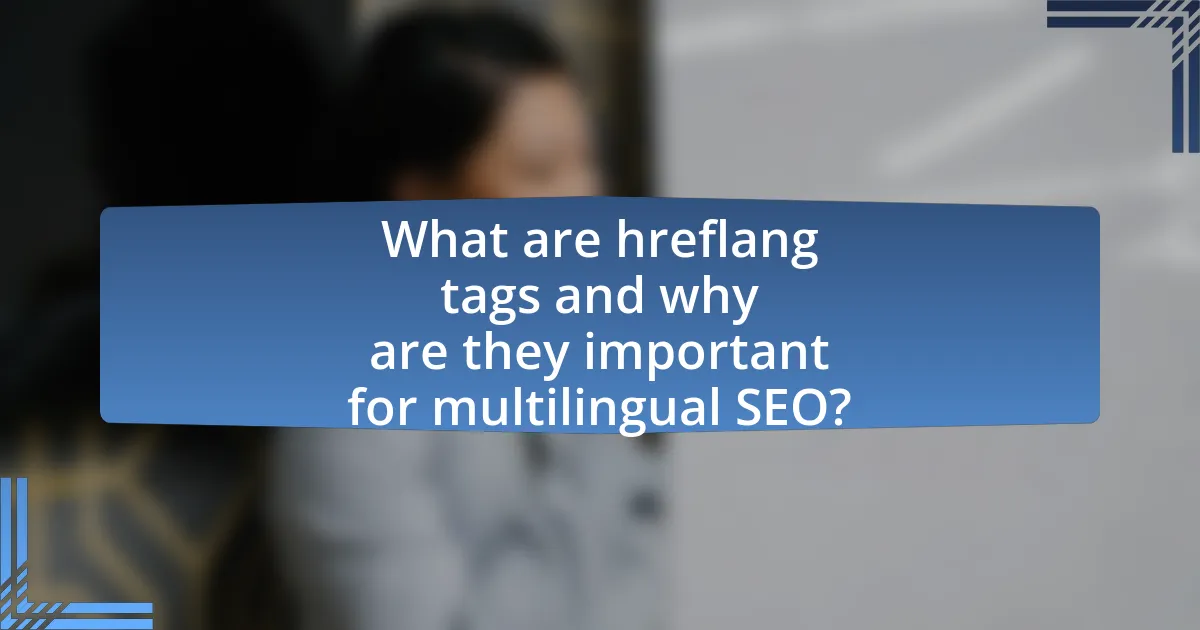Hreflang tags are essential HTML attributes that indicate the language and geographical targeting of webpages, playing a crucial role in multilingual SEO. This article provides a comprehensive overview of hreflang tags, detailing their function in search engines, key components, and benefits for multilingual websites. It also addresses common mistakes to avoid, methods for effective implementation, and tools for validation. By understanding and correctly utilizing hreflang tags, website owners can enhance user experience, prevent duplicate content issues, and improve search engine rankings for diverse audiences.

What are hreflang tags and why are they important for multilingual SEO?
Hreflang tags are HTML attributes used to specify the language and geographical targeting of a webpage. They are crucial for multilingual SEO because they help search engines understand which version of a page to show to users based on their language and location, thereby improving user experience and reducing bounce rates. For instance, if a website has content in both English and Spanish, implementing hreflang tags ensures that English-speaking users see the English version while Spanish-speaking users are directed to the Spanish version. This targeted approach not only enhances visibility in search results but also increases the likelihood of engagement from the appropriate audience.
How do hreflang tags function in search engines?
Hreflang tags function in search engines by signaling to them the language and regional targeting of a webpage. These tags help search engines understand which version of a page to serve to users based on their language preferences and geographical location. For instance, if a website has multiple versions of a page in different languages, the hreflang tag informs search engines about the relationship between these pages, ensuring that users see the most relevant version. This functionality is crucial for improving user experience and optimizing search visibility in multilingual contexts.
What are the key components of an hreflang tag?
The key components of an hreflang tag are the language code, the country code, and the URL. The language code specifies the language of the content, following ISO 639-1 standards, while the country code indicates the target region, adhering to ISO 3166-1 Alpha 2 standards. The URL directs users to the appropriate version of the page for that specific language and region. For example, an hreflang tag for English content targeted at users in Canada would look like this: . This structure ensures that search engines serve the correct version of a webpage to users based on their language and location, enhancing user experience and improving SEO effectiveness.
How do hreflang tags help prevent duplicate content issues?
Hreflang tags help prevent duplicate content issues by signaling to search engines the intended audience for specific content based on language and regional targeting. This ensures that users are directed to the most relevant version of a webpage, reducing the likelihood of multiple pages with similar content being indexed for the same search query. For instance, if a website has English content for both the US and the UK, hreflang tags can differentiate these versions, allowing search engines to serve the appropriate page to users based on their location. This targeted approach minimizes confusion for search engines and enhances user experience, ultimately improving SEO performance.
What are the benefits of using hreflang tags for multilingual websites?
Hreflang tags provide significant benefits for multilingual websites by ensuring that search engines serve the correct language or regional version of a webpage to users based on their location and language preferences. This targeted approach enhances user experience, as visitors are more likely to engage with content in their preferred language, leading to lower bounce rates and higher conversion rates. Furthermore, hreflang tags help prevent duplicate content issues by signaling to search engines which version of a page to index, thereby improving overall SEO performance. According to Google, implementing hreflang tags correctly can lead to better visibility in search results for different languages and regions, ultimately driving more relevant traffic to the site.
How do hreflang tags improve user experience?
Hreflang tags improve user experience by ensuring that users are directed to the most relevant version of a webpage based on their language and geographical location. This targeted approach reduces confusion and enhances satisfaction, as users can access content in their preferred language without encountering language barriers. For instance, a study by Google indicated that 56% of users prefer to browse websites in their native language, highlighting the importance of hreflang tags in catering to diverse audiences. By implementing these tags correctly, websites can significantly lower bounce rates and increase engagement, ultimately leading to a more positive user experience.
What impact do hreflang tags have on search engine rankings?
Hreflang tags primarily impact search engine rankings by helping search engines understand the language and regional targeting of a webpage. This understanding allows search engines to serve the most relevant version of a page to users based on their language preferences and geographical location. For instance, Google explicitly states that hreflang tags can prevent duplicate content issues and improve user experience by directing users to the appropriate content variant, which can lead to better engagement metrics and potentially higher rankings in local search results.

How can you implement hreflang tags effectively?
To implement hreflang tags effectively, include them in the HTML head of your web pages or in the HTTP headers. This ensures that search engines understand the language and regional targeting of your content. Each hreflang tag should specify the language and country code, following the ISO 639-1 and ISO 3166-1 Alpha 2 standards, respectively. For example, a tag for English content targeted at users in the United States would look like this: . Additionally, ensure that each page references all its alternate versions, creating a complete hreflang structure. This method helps search engines serve the correct version of your content to users based on their language and location, improving user experience and SEO performance.
What are the different methods to add hreflang tags to your website?
There are three primary methods to add hreflang tags to a website: using HTML link elements, implementing HTTP headers, and utilizing XML sitemaps.
The HTML link element method involves placing hreflang tags within the
section of your HTML documents, allowing search engines to identify language and regional targeting directly from the page. For example, a tag might look like this: .The HTTP header method allows you to specify hreflang tags in the HTTP response headers, which is particularly useful for non-HTML content types. This method requires server configuration to include the appropriate headers, such as: Link: https://example.com/fr/; rel=”alternate”; hreflang=”fr”.
The XML sitemap method involves including hreflang annotations within your XML sitemap, which can be beneficial for large websites. Each URL entry can include hreflang attributes, such as:
These methods ensure that search engines correctly interpret the language and regional targeting of your content, improving visibility in relevant search results.
How do you use HTML link elements for hreflang implementation?
To use HTML link elements for hreflang implementation, you insert specific link tags in the head section of your HTML document. Each link tag should specify the hreflang attribute, which indicates the language and optionally the region of the linked page, along with the href attribute that contains the URL of the corresponding page. For example, to indicate that a Spanish version of a page is available, you would include a tag like . This method helps search engines understand which language version of a page to serve to users based on their language preferences, thereby improving the site’s SEO for multilingual audiences.
What is the role of XML sitemaps in hreflang tag implementation?
XML sitemaps play a crucial role in hreflang tag implementation by providing search engines with a structured way to discover and index multilingual content. They facilitate the identification of different language versions of a webpage, ensuring that the correct version is served to users based on their language preferences and geographic location. This structured data helps search engines like Google to understand the relationships between various language-specific pages, thereby improving the accuracy of search results and enhancing user experience. According to Google’s guidelines, including hreflang tags in XML sitemaps can simplify the management of multilingual sites, especially when dealing with a large number of pages, as it allows for easier updates and maintenance of language associations.
What common mistakes should you avoid when using hreflang tags?
Common mistakes to avoid when using hreflang tags include incorrect language and region codes, which can lead to misinterpretation by search engines. For instance, using “en-US” for English in the United States is correct, while “en” alone is too vague. Another mistake is failing to include a self-referencing hreflang tag, which helps search engines understand the relationship between different language versions of the same page. Additionally, not implementing hreflang tags consistently across all relevant pages can create confusion and hinder proper indexing. Lastly, neglecting to test the implementation can result in errors that affect SEO performance, as tools like Google’s Search Console can help identify issues with hreflang tags.
How can incorrect hreflang tags affect your SEO efforts?
Incorrect hreflang tags can significantly harm your SEO efforts by causing search engines to serve the wrong language or regional version of your content to users. This misalignment can lead to decreased user engagement, higher bounce rates, and ultimately lower rankings in search results. For instance, if a French-speaking user in Canada is shown the English version of a webpage instead of the French version, they may leave the site quickly, signaling to search engines that the content is not relevant to their needs. Additionally, incorrect hreflang implementation can result in duplicate content issues, as search engines may index multiple versions of the same content, diluting the authority of each page. According to a study by Search Engine Land, proper hreflang implementation can improve organic traffic by up to 30% for multilingual sites, highlighting the importance of accuracy in these tags for effective SEO.
What are the consequences of missing hreflang tags?
Missing hreflang tags can lead to significant SEO consequences, primarily causing search engines to serve the wrong language or regional version of a webpage to users. This misalignment can result in decreased user engagement, higher bounce rates, and ultimately lower conversion rates, as users may not find the content relevant to their language or location. Additionally, without hreflang tags, search engines may struggle to understand the intended audience for each version of the content, which can dilute the effectiveness of SEO efforts and hinder the visibility of the correct pages in search results. Studies have shown that proper implementation of hreflang tags can improve organic traffic by ensuring that users are directed to the most appropriate version of a site, thereby enhancing user experience and engagement.

How do you troubleshoot hreflang tag issues?
To troubleshoot hreflang tag issues, first, verify that the hreflang tags are correctly implemented in the HTML of each page. This includes ensuring that the tags point to the correct language and regional versions of the content. Next, use tools like Google Search Console to identify any hreflang errors reported by Google, which can provide insights into misconfigurations. Additionally, check for proper syntax in the hreflang tags, ensuring that the language codes and country codes follow the ISO 639-1 and ISO 3166-1 Alpha-2 standards, respectively. Finally, confirm that the pages referenced in the hreflang tags are accessible and return a 200 HTTP status code, as inaccessible pages can lead to issues in recognition by search engines.
What tools can help you validate your hreflang tags?
Google Search Console is a primary tool that can help validate hreflang tags. It allows webmasters to check for errors in hreflang implementation and provides insights into how Google interprets these tags. Additionally, tools like Screaming Frog SEO Spider and Ahrefs can crawl websites to identify hreflang tag issues, such as missing or incorrect tags. These tools analyze the website’s HTML and report any discrepancies, ensuring that the hreflang tags are correctly set up for multilingual SEO.
How can Google Search Console assist in identifying hreflang tag errors?
Google Search Console assists in identifying hreflang tag errors by providing a dedicated report that highlights issues related to hreflang implementation. This report includes information on detected hreflang errors, such as missing tags, incorrect language or region codes, and conflicts between tags. By analyzing these reports, webmasters can pinpoint specific errors and take corrective actions to ensure proper multilingual indexing and user experience. The tool also offers insights into how Google interprets the hreflang tags, allowing for adjustments that align with best practices for multilingual SEO.
What are the best practices for fixing hreflang tag issues?
The best practices for fixing hreflang tag issues include ensuring correct language and regional targeting, validating the syntax of hreflang tags, and implementing a complete hreflang setup across all relevant pages. Correct language and regional targeting is crucial; for instance, using “en-US” for American English and “en-GB” for British English helps search engines serve the right content to users. Validating the syntax involves checking for proper formatting, such as using the correct XML structure or HTML attributes, which can be verified through tools like Google Search Console. A complete hreflang setup means that every page with hreflang tags should reference all its alternate versions, including itself, to avoid confusion for search engines. These practices are supported by Google’s guidelines on hreflang implementation, which emphasize the importance of accuracy and completeness in multilingual SEO strategies.
What are some tips for optimizing hreflang tags for better SEO results?
To optimize hreflang tags for better SEO results, ensure that each tag accurately specifies the language and regional targeting of the content. This includes using the correct ISO 639-1 language codes and, when applicable, the ISO 3166-1 alpha-2 country codes. Additionally, implement hreflang tags in both the HTML header and the XML sitemap to provide search engines with multiple ways to identify the language and regional variations of your pages.
Furthermore, maintain consistency across all hreflang tags by ensuring that every page has reciprocal tags pointing to each other, which helps search engines understand the relationships between different language versions. Regularly audit your hreflang implementation to identify and fix any errors, such as incorrect codes or missing tags, as these can lead to indexing issues and negatively impact SEO performance.
How can you ensure hreflang tags are correctly configured for all languages?
To ensure hreflang tags are correctly configured for all languages, implement a systematic approach that includes validating the language and regional codes, ensuring each page has the appropriate hreflang tags, and using a sitemap for comprehensive coverage. Each hreflang tag must accurately reflect the language and region of the content, following ISO 639-1 codes for languages and ISO 3166-1 Alpha 2 codes for regions. Additionally, each page should reference all its language variants, including a self-referential tag. Using tools like Google Search Console can help identify errors in hreflang implementation, ensuring that search engines correctly interpret the intended audience for each page.
What strategies can enhance the effectiveness of hreflang tags in your SEO plan?
To enhance the effectiveness of hreflang tags in your SEO plan, ensure accurate implementation by using the correct language and regional codes. This precision helps search engines understand the intended audience for each page. Additionally, maintain a consistent hreflang tag structure across all pages, as inconsistencies can lead to misinterpretation by search engines. Regularly audit your hreflang tags to identify and rectify any errors or outdated references, which can improve the overall performance of your multilingual SEO strategy. Furthermore, utilize a sitemap to list all hreflang tags, as this can facilitate better indexing by search engines.


